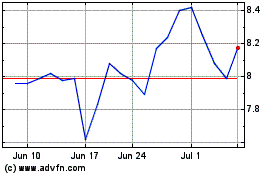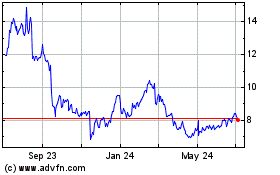Forgent Networks (d/b/a Asure Software) Letter to Stockholders
May 27 2009 - 5:00PM
Marketwired
Asure Software (NASDAQ: ASUR)
Open letter to shareholders
You should have received a proxy from Asure Software asking for
your vote regarding taking the company private. To many of you,
this idea may seem alarming because it immediately calls into
question how you will trade this stock in the future once it is no
longer listed on NASDAQ and does not report as a public company. We
understand those concerns because the Board of Directors has
wrestled with those same issues as both fellow shareholders and
concerned members of an independent board that is entrusted with
doing what is best for all of our shareholders.
There has been a significant amount of communication to you that
has been offered by people and groups outside of the company
expressing their opinions and concern regarding the company and the
go private transaction. Much of this information is confused and
misleading. The Board would like you to have the facts because we
know you want to be fully informed when you cast your final vote
regarding this very important issue.
I would like to share some candid thoughts with you regarding
how Asure's Board and Management arrived at the plan to take the
company private and the vision we have for the company going
forward.
Companies become publicly traded when they have the size, growth
and profitability to create an attractive market in their shares.
Asure has none of those qualifications today because it is a "start
over." The current company is attempting to inherit the benefits of
being publicly traded by growing into the shell of a company that
formerly existed but had a much larger infrastructure. We have
approached this assignment in two ways: Cutting cost and growing
revenue. The revenue growth has come from small acquisitions that
were affordable and organic growth in attractive markets. The
inherited cost structure has been grossly out of proportion to the
new software revenue even though the costs have been reduced over
93% since the start. Our goal has been to reach cash flow positive
by spending only what is necessary to grow revenue.
Today, if you look at just the software portion of the business,
it is near break even and growing which indicates that this portion
of the P&L is balanced. The overhead expenses, however, remain
too high which means we burn cash. We have continued to cut
overhead spending but with the slower revenue growth due to the
economic downturn, profitability will be seriously delayed unless
we reduce overhead expenses dramatically.
There are two major components of overhead that offer the relief
we seek: The cost associated with being publicly traded and our
building lease. The building lease is fifteen years with four
remaining and we have explored for years every legal method of
extricating the company without result to date. The cost associated
with being publicly traded is a collection of expenses related to
government compliance, legal and accounting that amount to more
than $1 million a year.
We have chosen to pay for top tier services because the Board
believes that it is in all shareholders' best interest to ensure
the integrity of financial and compliance reporting. However, it is
difficult for a company of our size to afford those public company
expenses. While some would argue that we could remain public and
save expense by cutting the quality of services and take more risk
with compliance, the Board has always placed a premium on the
integrity of financial and compliance reporting and believes that
such risk is not in shareholders' best interest.
Going private would eliminate some cost, such as Sarbanes-Oxley
compliance, completely and would considerably reduce the risk of
switching to lower cost services such as legal and accounting. The
net result would be a savings of about $250,000 per quarter which
would reduce the cash out flow significantly and accelerate the
time to profitability. Revenues are growing quarterly and we expect
to reach break even under these conditions by the end of 2009.
If we are unsuccessful in taking the company private and
reducing these expenses, then the choices would include taking
longer to reach profitability or reducing cost in the core software
business. The choice to remove $250,000 per quarter from operations
could significantly impair the ability to grow revenue and to
remain competitive. Said differently, if we were unsuccessful in
taking the company private, we would be faced with incurring
significant risk or cutting the core business to afford
infrastructure costs that frankly don't contribute to helping the
company achieve its revenue goals.
These are difficult choices that the Board has carefully
considered for more than a year with the help of many outside
professionals. After careful consideration, the best choice seems
clear: Go private, save expenses, keep the business healthy and
reach profitability.
The Board cares about share liquidity -- yours and their own.
They believe that liquidity is already an issue today because the
stock is so thinly traded. If the company is delisted from NASDAQ,
as it currently faces, then not only will liquidity decline further
on the Over the Counter Bulletin Board but be burdened with public
company expenses. While it is possible to delay delisting by
exercising a reverse stock split, history indicates that the move
can be temporary and share prices return to below the minimum bid
price unless accompanied by an event such as profitability.
The Board believes that a profitable, private software company
that is growing in a strong market, such as Work Force Management,
will be an attractive acquisition candidate in a few years that
could provide an attractive return to our shareholders. In the
meantime, we intend for the stock to be traded on the Over the
Counter Market Pink Sheets, which provides significant liquidity to
over five thousand other companies today. In fact, over $123
Billion traded on the Pink Sheets in 2008 which is an 800% increase
in volume since 2001.
These are difficult circumstances that lead to difficult
choices. On the other hand, we have great opportunities ahead if we
execute our business plan. We have a growing software business;
cash without the need to borrow; no debt and an experienced team
that is passionate about being successful.
Please give your full consideration to this proposal and vote
FOR the proposals on your proxy.
Sincerely,
Richard N. Snyder
Chairman and Chief Executive Officer
Asure Software (NASDAQ:ASUR)
Historical Stock Chart
From May 2024 to Jun 2024

Asure Software (NASDAQ:ASUR)
Historical Stock Chart
From Jun 2023 to Jun 2024
